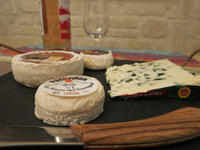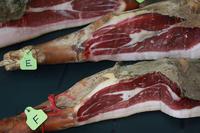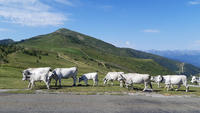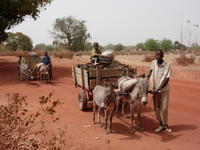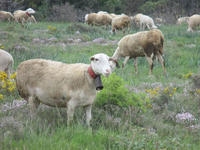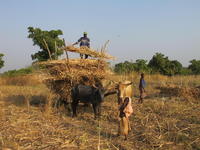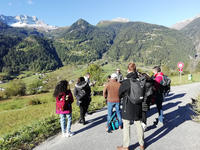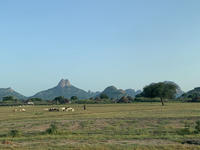Presentation
Last update: 1 September 2022
Why a joint scientific project?
Established in 2011, UMR Selmet operates on the basis of scientific projects that are renewed every four to five years. The unit seeks to integrate several complementary viewpoints and disciplines to tackle the complexities of livestock farming. This allows us to better respond to development issues and to position ourselves on "research fronts". It also encourages comparative approaches between the unit’s various study sites located in many different parts of the world. The unit’s three research groups (ARE, ALTER, DEFIT) consequently work on the same project.
What are the priorities for the new scientific project?
For the period 2021-2025, the unit aims to produce knowledge to support transitions on family, pastoral and mixed crop-livestock farms.
This project revolves around five themes. Two aim to align the unit's work with current scientific "Agroecology" and "Digital" developments. The three others aim to put into perspective the contribution of livestock to the sustainable development of "food systems" and "territories" in light of "global changes".
Diagram: The five themes of the SELMET 3.0 scientific project
Environmental impacts of livestock and adaptations of pastoral livestock systems to global changes theme
Global changes are changes occurring in different parts of the world at the same time and springing from the same processes. Among those affecting Mediterranean and tropical livestock systems, UMR SELMET mainly works on climate change, predation and changes in land use and occupation. These changes affect livestock activities, territories and the resources associated with them. Livestock farms thus are required to transform themselves by adapting and innovating while limiting their impacts, particularly with regard to climate change, biodiversity and pollution.
To accompany these dynamics in different contexts, this theme is structured around three objectives:
- Understand livestock farming practices and assess their environmental impacts through field measurements and ex-post or ex-ante assessments at the scale of the farm or grazed areas, but also at the scale diverse livestock farming systems within a territory; these approaches are used to qualify and quantify the positive and negative impacts of livestock farming on the environment;
- Identify the diversity of household trajectories and factors of resilience and vulnerability of livestock systems in the face of global change based on surveys and interviews with stakeholders; the aim is to use past and current dynamics to understand how activities (livestock and others) and sources of income (production, transfers, etc.) are organized to cope with changes in their environment;
- Understand and support the adaptation of systems to global changes and the management of the environmental impacts of livestock farming, from the local to the global level, using prospective approaches to compare evolution scenarios; this involves supporting the design and implementation of adaptations aiming to strengthen the resilience of livestock farming activities, produce services and reduce negative impacts.
"Food transitions” theme
The food transitions underway in Europe and elsewhere in the world are a major factor behind the evolution of livestock farms that we are examining in our scientific project. The main objective of our work is to understand the recomposition of food systems in light of the growing global demand for animal products and the strengthening of quality requirements that may result in the emergence of new standards. It focuses on three lines of research:
- Analyzing the links between the diversity of modes of production and marketing of animal products, and changes in consumption patterns;
- Analyzing and supporting quality and origin-linked management schemes, and understanding the place of local products in transitions;
- Assessing the links between value chain governance, social equity and consumer expectations.
|
|
|
Agroecology and sustainable development of Mediterranean and tropical livestock systems theme
Pastoral, agro-pastoral and mixed farming systems in the Mediterranean and tropical regions studied by Selmet rely on few artificial components and use low levels of chemical inputs. Consequently, the main challenge in these systems is to maintain the ecological services provided by livestock while contributing significantly to local food systems. For SELMET, agroecology for sustainable development means making better use of the role of animals in agro-ecosystems in order to sustainably increase the autonomy, productivity, contribution to environmental services and resilience of livestock systems. More specifically, this involves:
- Enhancing the natural resources on which these systems are based (pastures, water, soil) to produce better and more;
- Bringing more biological diversity into these systems, defining its functions and using it through adapted practices;
- Managing diverse systems in a changing environment, which requires more knowledge and skills, drawn from both informal and scientific knowledge;
- Increasing the recycling of crop and livestock co-products by developing synergies between plants, soil and animals at different scales;
- Responding to the stakes of food sovereignty and financial security for farmers.
In our research, we apply agroecology principles to livestock farming to support the design of livestock systems that fulfil multiple functions, ensuring the best compromises. Our research work has three main objectives: (1) Study the change dynamics in livestock systems with respect to the principles of agroecology, (2) Develop biotechnical levers for the design of agroecological livestock systems and (3) Design and evaluate agroecological livestock systems.
|
|
|
|
“Territories" theme
We assume that analyses of transformations of livestock activities on a territorial scale enable the transitions in progress to be better understood and supported.
These analyses involve two complementary approaches. One takes "livestock farming" as the point of departure to discover its territorial dimensions, the second starts by considering an entire territory to analyze the specific contribution of livestock farming activities to territorial development, reinforcing their recognition alongside other activities.
This research is conducted in partnership with local communities and governance bodies in charge of these territories to reorient and support development trajectories.
Three main research themes are identified for this work:
- Understand, assess and support territorial animal health management;
- Support the integration of pastoral and crop-livestock dynamics in the territories and co-design sustainable trajectories;
- Understand and evaluate the multiple functions of livestock farming in territories to promote sustainable co-management methods and support transitions.
|
|
|
“Digital" theme
Digital technologies are being used increasingly in livestock farming due to their potential to support technical and economic objectives (technical efficiency, labour productivity, etc.) while encouraging an agroecological transition of production principles. Setting up 'digital livestock farming' presents a number of challenges, particularly in Mediterranean and tropical areas where agro-pastoral and family livestock systems face varied constraints that are challenges for the SELMET agents working on this theme.
Within SELMET, the expertise and research projects associated with the digital theme cover different scales, from genetics to the organisation of sector actors, via the animal and its resources. These may involve adapting existing technologies to Mediterranean and tropical contexts, or even developing information processing methods or new technologies specifically dedicated to them. Digital tools can also be used in research to generate original data measured in situ, or to increase the capacity to produce data for a more detailed understanding of factors driving variations in the performance of livestock farming activities. To carry out these activities, the UMR is part of an international partnership network involving various innovation stakeholders (from researchers to entrepreneurs, including farmers and groups of farmers).
How shall the new scientific project be organized?
The themes are interdisciplinary. They reflect the shared desire of the unit's members to "exchange" and "build together". As such, they serve as tools for coordination and capitalization. To implement this project, the unit aims to generate around these five themes convergences and synergies between our different fields and projects. Five pairs (or trinomials) of facilitators are orchestrating this coordination.
Last update: 1 September 2022
